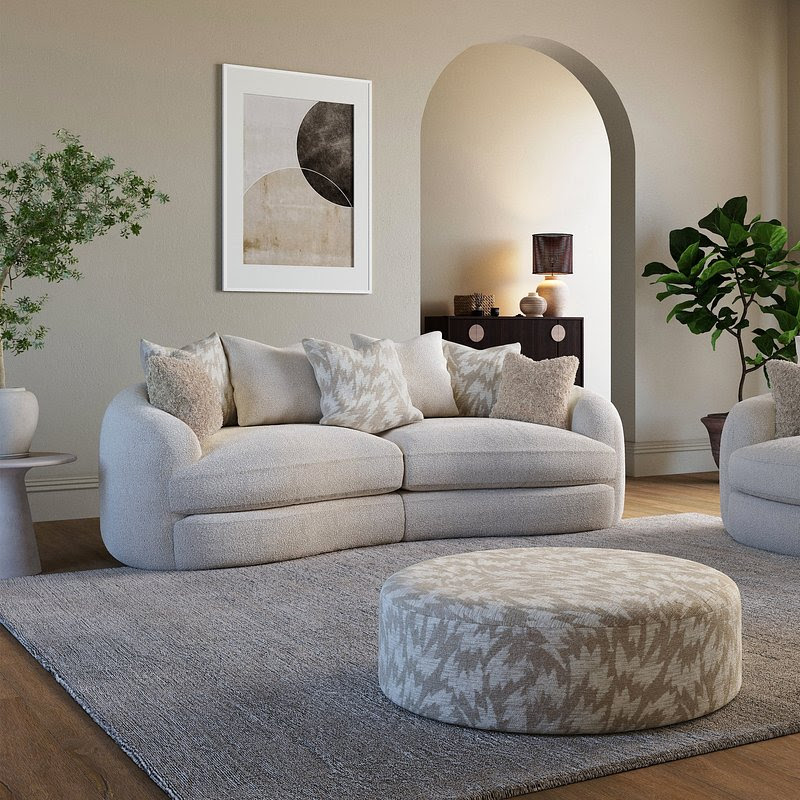“In the realm of interior design, the pursuit of wellbeing continues to be a significant influence on décor choice,” says Lucy Mather from Arighi Bianchi, a viewpoint shared by fellow interior design experts.
“At the heart of this movement is the concept of Sense-scaping,” says Mather, “which is the practice of using all five senses to create a desired mood or experience within a particular environment.”
In interiors, Sense-scaping is reshaping how we think about and design our living spaces in 2025. So how can we apply this design principle in our homes – we asked three experts to explain.
According to Lucy, “The Sensescaping trend in interior design is about more than decorating a home to just make it look good. Rather it’s a holistic approach to creating interiors that engage all five senses, fostering immersive, wellness-focused environments. The trend goes beyond aesthetics to design spaces that evoke emotional responses and enhance well-being by carefully considering how interiors look, feel, sound, smell, and even taste.
“Dedicated quiet zones for relaxation or mindfulness, free from external noise pollution, are important within this trend as well as layered lighting schemes, including soft uplights, dimmable lamps, and candlelight, to create mood-enhancing atmospheres.

“By curating spaces that cater to all the senses, this trend creates immersive environments that nurture both physical and emotional health. Its focus on personalisation ensures that each space feels uniquely comforting and deeply engaging.”
Megan Baker from My Fitted Bedroom agrees. She says that Sense-scaping is rooted in the pursuit of wellbeing within the home and is an approach focuses on creating sensory-rich environments that enhance comfort, personal connection and holistic living.
She explains, “We see first-hand during our personalised design process that customers want colours and layouts that are calming and will reduce stress. They want their spaces to positively impact their senses and overall wellbeing, beyond being something functional or just pleasing to the eye.”
Bedrooms, in particular, are a key focus for the Sense-scaping design approach. “Incorporating elements like calming colour palettes, smart storage solutions, and minimal patterns can transform a bedroom into a tranquil oasis. Colour psychology plays a vital role, while clutter-free designs naturally make a room feel calm and inviting,” Baker explains. “Sense-scaping can also improve your well-being and productivity, especially if you work from home.”
And according to Matt Thomas of Apollo Blinds, designs incorporating natural textures, biophilic elements, and earthy colour palettes are becoming prevalent, fostering a connection to nature and promoting well-being.
Thomas notes the transformative power of fabric in Sense-scaping. He says, “Handwoven textiles and artisanal materials are gaining traction as consumers seek authenticity and a deeper connection to their homes. Velvet curtains, for instance, add a touch of luxury and pair beautifully with jewel-toned décor. Natural materials like linen, jute, and wool are also in high demand.
“Linen window blinds complement earthy palettes, adding warmth and character to any room. Fabrics evoke comfort and emotions through texture, colour, and pattern, enhancing tactile and visual sensations to shape the ambiance and overall experience.”
Mather highlights that natural materials are playing a pivotal role in this trend. “Emphasis is placed on materials that feel good to touch, such as soft wools, velvets and smooth stone and marble. Elements like indoor plants, organic forms, and natural light are prioritised to connect interiors with the outdoors; and furniture and spaces are crafted for comfort, featuring rounded edges, cushioned seating and inviting surfaces.”
Insights from the Milan Furniture Show further underline this shift. “Designers showcased furniture with soft, rounded lines, moving away from strict minimalism to create more dynamic and inviting spaces. Curved side tables, armchairs, and sofas are trending, enhancing comfort and fluidity within interiors,” Mather adds.
Engaging Your Senses – Six ways to incorporate sensory design into your home to create an environment that engages all your senses and promotes wellbeing…
1. Incorporate Tactile Materials
- Use fabrics like velvet, bouclé, faux fur, and linen for furniture, cushions, and throws to add depth and comfort.
- Include natural materials like wood, stone, and ceramics to provide a variety of textures.
2. Play with Lighting
- Add dimmable lights and smart bulbs to adjust brightness and colour based on mood or activity. Consider warm, soft-toned lighting for a cosy atmosphere in the evenings.
- Use natural light by incorporating sheer curtains or blinds to soften the ambiance.
3. Embrace Calming Colours
- Apply principles of colour psychology to choose hues that evoke desired emotions, like blues and greens for calmness or yellows for energy.
- Opt for earthy tones and neutral palettes to create a soothing backdrop.
4. Enhance Soundscapes
- Install soft background music systems or white noise machines to reduce stress.
- Use thick rugs, upholstered furniture, and curtains to absorb sound and minimise echoes. Acoustic wall panels are also important within this trend too.
5. Focus on Scents
- Use essential oil diffusers, scented candles, or fresh flowers to introduce pleasant aromas that suit each room’s purpose (e.g., lavender for relaxation in the bedroom).
- Incorporate natural scents from materials like cedarwood or eucalyptus.
6. Design for Movement and Flow
- Arrange furniture to create open, easy-to-navigate spaces that feel welcoming and functional.
- Use rounded furniture edges and flowing layouts to enhance a sense of comfort and safety.
- Include soft rugs and mats that feel inviting underfoot.
The Sense-scaping trend is about more than aesthetics; it’s about making your home a haven for relaxation and personal connection. Whether through sumptuous velvets, calming colour schemes, or carefully curated textures, this trend invites homeowners to craft spaces that nourish the body, mind, and soul